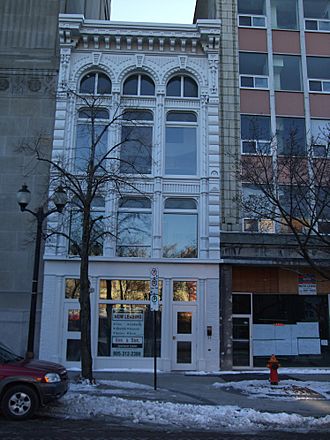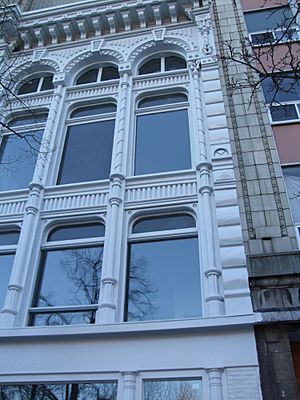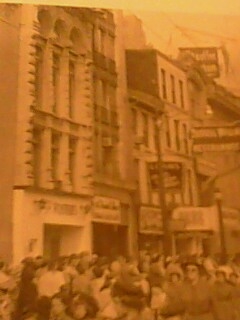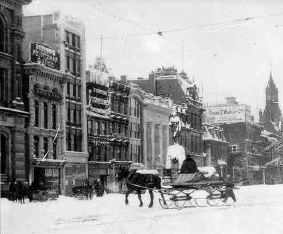Victoria Hall (Ontario) facts for kids
Quick facts for kids Victoria Hall |
|
|---|---|

Victoria Hall, 2009
|
|
| Former names | "Fosters" (informal) |
| General information | |
| Type | Commercial Building |
| Architectural style | Victorian |
| Location | Hamilton, Ontario |
| Address | 68 King Street East |
| Coordinates | 43°15′20.5″N 79°52′02″W / 43.255694°N 79.86722°W |
| Construction started | 1887 |
| Completed | 1888 |
| Design and construction | |
| Architect | William Stewart |
| Awards and prizes | Designated under the Ontario Heritage Act, National Historic Site |
Victoria Hall is an old building in Hamilton, Ontario, Canada, that used to be a shop. It's in downtown Hamilton, right across from Gore Park, a busy area. For a long time, it was called the "Foster Building" because it was home to a fancy clothing store named Foster's. Some people still use that name today!
This building is special because its front (called a facade) is made of beautiful, hand-crafted metal sheets. This kind of design is quite rare. In 1995, Victoria Hall was named a National Historic Site. This means it's a very important place in Canada's history. It's also one of the oldest buildings on King Street with a metal front, showing how buildings used to look a long time ago.
Contents
Building History
Victoria Hall was built a long time ago, between 1887 and 1888. A Hamilton architect named William Stewart designed it. It was built for Alexander Bruce, who was a well-known lawyer in Hamilton. The front of the building was made to look like expensive stone, showing off wealth.
Victoria Hall is part of a line of old shops that face Gore Park. This area has always been the main shopping spot in the city. It's also where many public events happen. Victoria Hall is one of the last big, fancy Victorian-style buildings left in the Gore Park area.
Over the years, many different businesses called Victoria Hall home. These included a piano shop, a radio store, a tea broker, and even a newspaper office. There was also a bicycle company and a hat shop.
In 1952, a high-fashion women's store called Foster's moved into Victoria Hall. About ten years later, Foster's also took over the MacKay Building next door. These two buildings were then treated as one property. When a new shopping complex called Jackson Square was built in the 1970s, Foster's left Victoria Hall in 1979. After that, Victoria Hall was empty for a very long time until it was finally fixed up.
Special Features of Victoria Hall
The unique parts of Victoria Hall that make it important are:
- Its front, which is made of hand-crafted metal sheets. This metal covers the entire front of the building above the ground floor.
- The metal front has three sections, like an Italian-style building. The decorations on it stick out a lot.
- On the first two floors, the windows are flat at the top but rounded at the corners. They are separated by tall columns.
- On the top floor, the windows are shaped like half-circles. They have fancy decorations above them.
- A large, decorated ledge (called a cornice) sits at the very top of the building's front.
- The metal front looks just like it's made of fancy carved stone, even though it's metal.
- Its great location on King Street, very easy to see.
- It's part of a continuous row of shops along King Street.
- It faces Gore Park, which is an open, green space across the street.
Bringing Victoria Hall Back to Life
After Foster's left, a dentist from another town bought the buildings. The dentist tried to sell them for a lot of money, but no one wanted them. In the mid-1990s, the city almost bought the property itself. But politicians decided not to because the buildings were in such bad shape. Many years passed.
Another owner then bought the property, thinking it would sell for millions. A real estate agent from Toronto tried to help, but still, nothing happened.
Finally, in 2005, investors from outside Hamilton bought Victoria Hall and the MacKay Building for $300,000. They hired an engineering company from Toronto to help. This company came up with a plan to spend $3 million to fix up the buildings. The plan included shops, offices, and ten "live-work" spaces. These are places where people can both live and run their businesses, which are popular in other cities.
The project received about $300,000 in loans from the city. These loans didn't have any interest. Gordon Moodie, who helps with grants for downtown Hamilton projects, worked with the engineering company. They applied for a special fund called the Commercial Heritage Properties Incentive Fund. This fund could give the Victoria Hall project a big boost.
In 2008, the renovations on Victoria Hall and the MacKay Building began. The MacKay building now has five large apartments, each with five bedrooms. The apartments on the second and third floors were ready for people to move in by September 2008. Victoria Hall has two apartments: one with five bedrooms on the top floor (which has a very tall ceiling) and one with four bedrooms on the second floor. The building has been repainted to its original white color, just like it looked in old photos from the late 1800s.
A National Historic Site
Victoria Hall was officially named a National Historic Site in 1995. It earned this title because it's a great and rare example of a commercial building. Its front is made of decorative, hand-made metal sheets. At the time it was named, Victoria Hall's well-designed metal front was mostly still in its original condition.
Even though the building was named a National Historic Site in 1995, it doesn't yet have a special bronze plaque. These plaques are usually placed on historic sites to tell people about them. Owners of National Historic Sites talk with Parks Canada about getting a plaque. Some buildings don't have plaques for different reasons. Sometimes the owners don't want one. Other times, the building was named a historic site recently. Also, there are many new historic sites in Ontario, so there's a long list of requests for plaques. There are more sites that need plaques than Parks Canada can currently provide.






